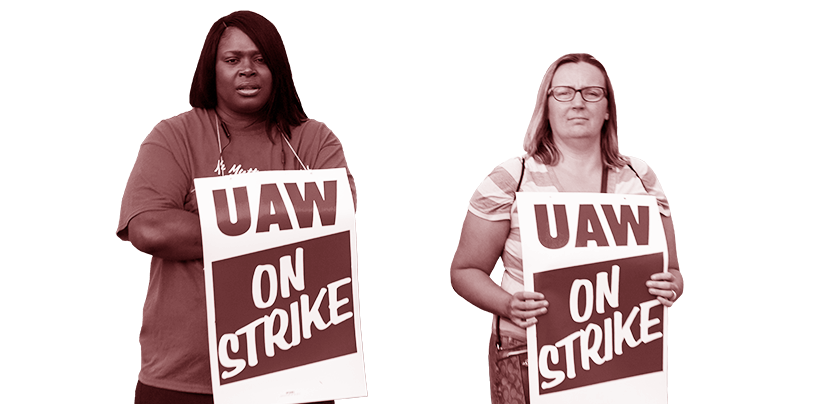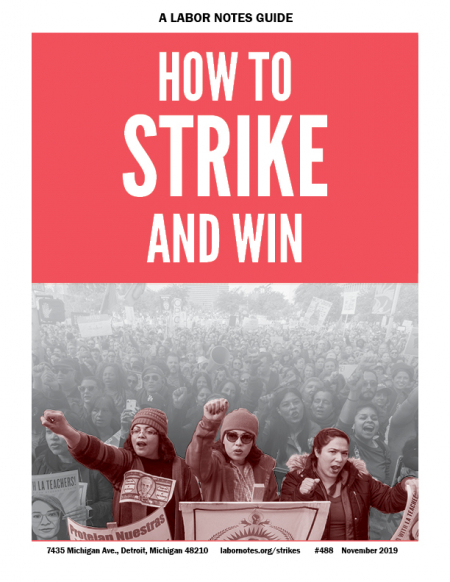Why Strikes Matter

Strikes are the strongest tool in workers’ toolbox—our power not just to ask, but to force our employers to concede something. Photo: Jim West / jimwestphoto.com.
Strikes are where our power is. Without a credible strike threat, workers are at the boss's mercy.
How to Strike and Win
A Labor Notes Guide
labornotes.org/strikes
The Big Picture
Know Your ABC's
Building Blocks
- Turn Up the Heat
- Organize the Organized
- Democracy: Who Owns the Strike?
- Community: Who Else Owns It?
- How to End a Strike
At a Glance
“Why do you rob banks?” a reporter once asked Willie Sutton. “Because that’s where the money is,” the infamous thief replied.
Why go on strike? Because that’s where our power is.
Teachers in West Virginia showed it in 2018 when they walked out, in a strike that bubbled up from below, surprising even their statewide union leaders.
No one seemed concerned that public sector strikes were unlawful in West Virginia. “What are they going to do, fire us all?” said Jay O’Neal, treasurer for the Kanawha County local. “Who would they get to replace us?” Already the state had 700 teaching vacancies, thanks to the rock-bottom pay the strikers were protesting.
After 13 days out, the teachers declared victory and returned to their classrooms with a 5 percent raise. They had also backed off corporate education “reformers” on a host of other issues.
The biggest lesson: “Our labor is ours first,” West Virginia teacher Nicole McCormick told the crowd at the Labor Notes Conference that spring. “It is up to us to give our labor, or to withhold it.”
That’s the fundamental truth on which the labor movement was built.
Strikes by unorganized workers led to the founding of unions. Strikes won the first union contracts. Strikes over the years won bigger paychecks, vacations, seniority rights, and the right to tell the foreman “that’s not my job.” Without strikes we would have no labor movement, no unions, no contracts, and a far worse working and living situation.
In short, strikes are the strongest tool in workers’ toolbox—our power not just to ask, but to force our employers to concede something.
DISCOVER YOUR POWER
The key word is “force.” A strike is not just a symbolic protest. It works because we withhold something that the employer needs—its production, its good public image, its profits, and above all its control over us.
As one union slogan has it, “this university works because we do”—or this company, or this city. A strike reveals something that employers would prefer we not notice: they need us.
Workplaces are typically run as dictatorships. The discovery that your boss does not have absolute power over you—and that in fact, you and your co-workers can exert power over him—is a revelation.
There’s no feeling like it. Going on strike changes you, personally and as a union.
“Walking into work the first day back chanting ‘one day longer, one day stronger’ was the best morning I’ve ever had at Verizon,” said Pam Galpern, a field tech and mobilizer with Communication Workers Local 1101, after workers beat the corporate giant in a 45-day strike in 2016.
“There was such a tremendous feeling of accomplishment. People were smiling and happy. It was like a complete 180-degree difference from before the strike,” when supervisors had been micromanaging and writing workers up for the smallest infractions.
In a good strike, everyone has a meaningful role. Strikers develop new skills and a deeper sense that they own and run their union. New leaders emerge from the ranks and go on to become stewards.

SUPPORT LABOR NOTES
BECOME A MONTHLY DONOR
Give $10 a month or more and get our "Fight the Boss, Build the Union" T-shirt.
New friendships are formed; workers who didn’t know or trust one another before forge bonds of solidarity. A few stubborn co-workers finally see why the union matters and sign on as members.
Allies from faith groups, neighborhood groups, or other unions adopt your cause. You and your co-workers lose some fear of the boss—and the boss gains some fear of you.
In all these ways and more—not to mention the contract gains you may win—a strike can be a tremendous union-building activity.
JUST THE THREAT
Sometimes coming to the brink of a strike is enough to make your employer blink. Workers at an Indiana truck plant in 2016 got as far as hauling burn barrels to work every day to show they were ready to hit the picket lines. The company, Hendrickson International, averted a strike by agreeing to phase out two-tier wages and pensions.
The benefits of a humbled employer can last beyond a single contract cycle. After Seattle’s grocery chains in 2013 came within two hours of a strike—the union dramatized the impending deadline with a giant countdown clock—the chains scrambled to avoid a repeat in 2016 by settling a new contract before the old one expired.
The transformation can also reach beyond the workplace. Strikes open up our political horizons, expanding our sense of what’s possible if we use our power.
This summer, a general strike in Puerto Rico brought down two corrupt governors in quick succession. This fall, Amazon workers struck for a day as they pushed their employer to take on climate change. Large-scale strikes will be crucial if we expect to rescue our world from the corporations that promote poverty and environmental collapse. The 1% are not going to hand us anything.
A NEW UPSURGE?
Strikes in the U.S. have declined dramatically over the past half-century. Since 1947 the Bureau of Labor Statistics has tracked strikes and lockouts involving 1,000 or more workers.
From 1947 through 1981, there were hundreds of such big strikes each year. Last year there were 20. The decline in strikes is a reflection of unions’ diminishing power and numbers—and a reason for it. But strikes aren’t dead.
Over the years it has gotten harder (in some ways) to strike and win. Some of the best tactics have been outlawed; some of the best sources of leverage have been neutralized.
A hundred years ago, striking took physical bravery. Your employer might hire armed thugs to attack you. Today in the U.S. that’s less likely. Employers have found more sophisticated ways to weaken strikes.
Still, it takes real courage to walk out. You might lose your job, and a court might deem your firing legal. If striking is illegal in your state or sector, you might have to break the law. If union leaders are reluctant to strike, you might have to out-organize them.
Or the union could miscalculate—you might find you don’t have enough leverage to win. You might have to walk back in empty-handed.
Workers today have to soberly assess their power up against rich, complex, global corporations. Sometimes a strike alone may not be enough to win; it might have to be part of a larger campaign. But the strike itself remains a powerful tool—economically powerful, personally transformative to the participants, and inspiring to the public.
The spreading wave of teacher strikes has won many material improvements for teachers and schools, and has raised teachers’ expectations across the country for what they and their students deserve. It has caught the public imagination, rallied whole communities behind the strikers, and put strikes back on the agenda.
Optimists in the labor movement (and worriers in the business world) are asking, who’s next? Will workers in the private sector catch the strike spirit? In 2019 we saw General Motors auto workers, Toledo nurses, Pennsylvania locomotive workers, Uber and Lyft drivers, and Stop & Shop grocery workers all hit the bricks. Could this be the beginning of the next big upsurge? Let’s make it so.
ABOUT THIS MANUAL
This booklet is meant to be of use to anyone who wants to know how to strike and win, whether you’re an officer charting a course for your union or a group of rank-and-filers who want to lead from below.
Successful strikes usually rely on months or years of groundwork. So this manual starts long before, describing the contract campaign and preparation required to put a strike on the table.
The stories and quotes included here are drawn mainly from Labor Notes reporting, often from the frontlines of the strikes described, and from our handbooks.





